The Forest of the Green Soul Hides
Its Wounds in the Iron Birch Tree
Fir Forest at Woljeongsa Temple on Mt. Odaesan
Text by. Hong Seok-hwan Photo by. Ha Ji-kwon
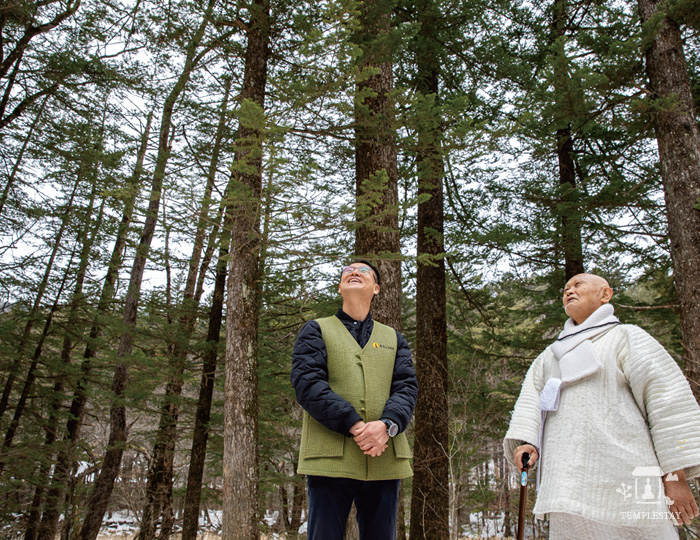
Temples, Forests and Their Special Relationship
Among Korea's best hiker-friendly forests, the most peaceful and beautiful is without a doubt the Fir Forest Trail at Woljeongsa Temple. The harmony that exists between the level walking path and vertical, old fir trees creates a special environment unrivaled anywhere else. The occasional mix of old deciduous trees also adds to the charm. Like a huge growth ring that cannot be measured to calculate a tree's age, the trees seem to grow forever, endlessly straight and high toward the sky. When you stand here, even with no thought of meditation, you are bound to be immersed in deep thought.
Ven. Wonhaeng says, “For the monks of Woljeongsa Temple, the forest on Mt. Odaesan is a school to offer prayers, practice Seon, and do other Buddhist practices. The forest is the temple, and the temple is the forest. With such pride, we created a nursery garden and planted fir saplings on the land that stretched from Woljeong Street to Woljeongsa Temple. When I came to Woljeongsa Temple about 60 years ago, it was completely in ruins with only one pagoda left standing. There was no financial means to run the temple, let alone carry out any Buddhist projects. With so many difficulties, the only thing we could trust and rely on was the forest. We let the slash-and-burn farmers collect and sell products from the forest and maintained the temple by receiving a portion of their income.”
For Ven. Wonhaeng—a member of the Elders Council of the Jogye Order of Korean Buddhism—the fir forest is like an old dharma brother. Having entered monastic life at Woljeongsa Temple in the late 1960s, he has been a resident monk at the temple for over 60 years. Indeed, he may be called an “eternal mountain steward.” The forest of Woljeongsa Temple, as he remembers, has always embraced many life forms, enduring wounds both big and small. The complete tranquility that pervades the forest is evidence that it has endured for hundreds of years. The tranquility is also deeply intertwined with the wounds of past hardships the forest has silently endured throughout the history of the Korean Peninsula.
Now, I want to look at the wounds this forest has kept to itself. They too are a part of the temple's 1,400 years of history and add their own unique beauty to this Korean mountain temple that we must not forget. The pain of the forest is also a part of the life and memories of Ven. Wonhaeng. Looking into the forest's painful past gives us an opportunity to finally repay the forest's infinite generosity and the asceticism of Woljeongsa's monks which helped protect the forest. The limitless generosity of the forest should never be taken for granted.
The Fir Forest at Iljumun Gate
The fir forest that unfolds before us the moment we enter Iljumun (One Pillar Gate) draws us into a new world. It is a mystical experience that seems to transcend time and space. I feel that I and nature are one, and that I and the Earth and the fir trees are connected by an invisible string. I feel like I can understand just a little of the relationship between nature and time that cannot be known in the short life of a human being. Was this fir forest the reason Woljeongsa Temple was founded here 1,400 years ago? When you walk barefoot on the ground, you can feel the beauty of a new world more intimately.
Questions sprang up in my head. How long has this fir forest been here? In the past, when Master Jajang set foot on Mt. Odaesan, was this fir forest here?
The oldest record of a fir forest at Woljeongsa Temple is a painting titled Woljeongsa, painted by Kim Hong-do (pen name, Danwon) in 1788 on his journey to Mt. Geumgangsan. In this painting, which is well over 200 years old, you can see that huge fir trees surround Woljeongsa Temple, making it look the same as it does now. However, in the painting there are only a few young fir trees around Budojeon Field, and no large trees are visible. The old trees were located on the south side of the temple near the current Cheonwangmun Gate. The stoutness of the fir trees is clearly evident in the picture. This is a fact we can confirm from realistic landscape paintings of the late Joseon era that depicted nature as it is.

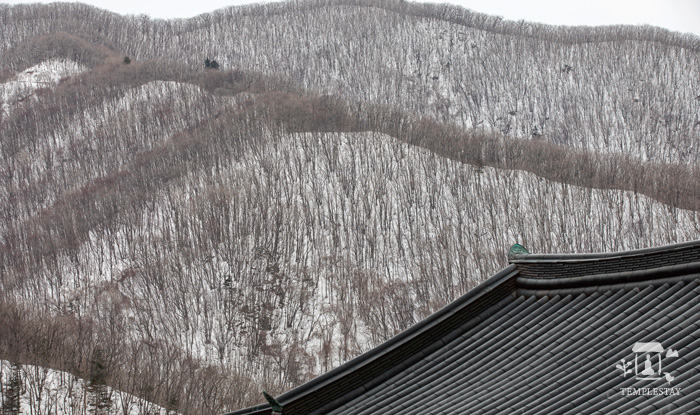
Since the fir forest of today is not much different than it was 200 years ago, wouldn't this forest have looked the same even 1,000 years ago? Unfortunately, that's not really the case. In 2006, I participated in the "Research for the Conservation of Fir Forests in the Woljeong District of Mt. Odaesan," conducted by the Odaesan National Park Service, and I examined the ages of many of the fir trees. Among the trees whose exact age I could confirm, the largest tree had a diameter of 84cm at chest height (Cir approx. 264cm), and was confirmed to be 102 years old. The oldest fir tree was relatively smaller, had a diameter of 64cm at chest height (Cir approx. 201cm), and was 135 years old. It was impossible to measure the age of trees exceeding 100cm in diameter at chest height for various reasons, but based on the growth rate of other trees, we estimated the oldest tree to be about 270 years old. Other than this exceptionally old tree, the largest trees measured an average of 130cm in diameter and were estimated to be around 180 years old.
Even the oldest fir trees now surrounding Woljeongsa Temple had not yet sprouted when Kim Hong-do painted Woljeongsa 200 years ago. Even if it is not a 1,000-year-old forest, there is no need to be disappointed because as each tree continues to sprout, grow, and die off, the fir forest continues to maintain the same size and composition now as it did then. I realized again that the perpetuation of life is a natural process and a tradition.
“When life was difficult and strenuous, I always walked this path. As I walked, the trees next to the road seemed to offer me silent comfort. This tree, now only a stump, was a dharma brother I relied on and communicated with. After leaning against it a while, I started to forget about my hardships, and peace pervaded my mind. Now I want to help this forest that has selflessly benefited others for so long because we must pass on the many benefits we received from the forest to our descendants. I feel that I have a responsibility to protect this forest, not just for the current generation, but for future generations too. I think it would be a good idea to start a program where tourists cannot enter certain forests for several years.”
As Ven. Wonhaeng said, even forests need rest. This is especially true as trees over 100 years old are falling down more frequently. While I agree with him about a “time off” program for forests, I wonder if giving forests two weeks of rest a year would be sufficient, perhaps during the weeks when the winter and summer practice retreats begin? In any case, giving the fir forest at Woljeongsa Temple time to rest, rejuvenate, and heal would be a good thing. Just as we ourselves rest here in this forest to become healthier, we should also give the forest time to rest.
Memory of the Iron Birch
What scars are hidden on Seonjae-gil, the path to enlightenment that connects Woljeongsa Temple to Sangwonsa Temple? The wounds hidden here and there seem to guide us to enlightenment. When you pass Budojeon Field and cross Banyagyo Bridge, another world unfolds where everything changes, including the road and forest. The road changes to an unpaved dirt road, and the forest changes from evergreen to broadleaf.
The history of this forest can also be traced back through records. During the Japanese Invasions of Korea (1592―1598), three of the four state archives in the country were destroyed, and the construction of new archives was carried out by the Joseon court afterward. The locations for the new archives were selected with safety from fire as the top priority. In 1606, an archive was built in the middle of a forest far away from Woljeongsa Temple, indicating the site was safe from fire.
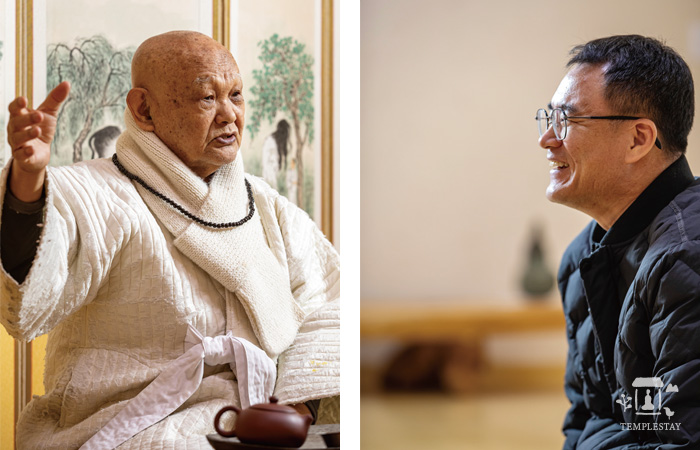
Is the middle of a dense virgin forest really safe from forest fires? Many people may question this, but it is true. In a dense broadleaf forest, a fire will be extinguished quickly. Even when the archive site was selected, this would have been a dense forest of broadleaf trees. After the establishment of the Odaesan State Archive, logging was prohibited within 30-ri (approx. 12km) of the site. This measure was taken because forest fires cannot spread quickly if the forest is dense. For this reason, 60 lay guardians and 20 monk stewards guarded the forest, so it would not have been possible to cut down trees around Woljeongsa Temple. Therefore, the broadleaf forest remained undisturbed for a long time.
If you look at the actual map created during the Japanese colonial period, you can see that the forest was protected as it was. If you follow the ridgeline east from Mt. Gyebangsan, it continues to the southeast ridge where the Kensington Hotel is currently located. Bordering the ridge, a forest of large deciduous trees is to the north. On the other hand, the mountains on the south, which were not protected by the temple, is mostly a treeless wilderness on the map. Although the distance is less than 12km, it seems certain that the forest around Woljeongsa Temple was left undisturbed up until the Japanese colonial period.
On Seonjae-gil Path, where you leave Budojeon Field behind, you will encounter another more diverse forest containing: ash trees, Korean birch trees, elms, dogwoods, cherry trees, oaks, three-flower maples, cypress trees, sycamores, teil trees, loose-flower hornbeam trees, heart-leaf hornbeam trees, Siberian crabapple trees, Korean maples, etc. The moment you enter, you feel you have to call out the names of all the trees surrounding Woljeongsa Temple.
In particular, trees often hard to find in other areas of Korea can be seen here, like iron birches and Korean birches. These two trees mainly grow in fertile forest soil that is moist, deep, and rich in nutrients. These members of the “birch family”—noted for their unique beautiful bark—have stems that are both colorful and also embellished with peeling bark. On Seonjae-gil, the iron birch trees with their black curling bark and the Korean birch trees with their white curling bark seem to be competing to see which is more beautiful. These two species of trees with such contrasting colors stand alongside each other on Seonjae-gil, like the black and white stones used in the game of “baduk” (“Go” in Japanese). Even in March, this place is still covered in snow, and the unique harmony of the black and white trees towering above the snow is obvious. The pleasure of fully appreciating this kind of scenic beauty is another reason to hike through this forest.
Woljeongsa Temple suffered the tragedy of being burned down by retreating soldiers in 1948, but has now been restored to its original stately appearance as if nothing had ever happened. At first glance, this forest also radiates a permanent sense of serenity as if nothing bad had ever happened here. It is rare to see old trees like the ones that grew here before, but thanks to the seeds left in the ground, the trees that appeared later still accentuate the beautiful surroundings of Woljeongsa Temple but in a different way. The forest never surrenders to adversity; it always recovers and carries on.
As you approach Sangwonsa Temple at the end of Seonjae-gil, the majestic forest unfolds. Was this what the forest looked like when Master Jajang first set foot on Mt. Odaesan 1,400 years ago? As you go deeper into the forest, which did not suffer the scars of the Japanese colonial period, you can even sense the lushness of the primeval forest that was here before. However, the path is more difficult and requires more determination of the hiker.
Looking at the forest map of Korea (created in 1910) during the Japanese colonial period, of all the forests in Korea (except North Korea), only about 10% had large trees. This is because most of the forests were cut down during the late Joseon Dynasty. Therefore, Woljeongsa's well-maintained primeval forest would have been an excellent source of timber.
It is said that the Japanese colonial government exported many large iron birch trees from here to Japan, implying that many grew here. A narrow-gauge railway was built up to Sangwonsa Temple to transport the felled trees, and a “bomagi”—a temporary facility with a dam to hold water—was built to move the trees into the valley.
The bomagi, now gone, was used to hold the felled trees in a valley, and after a heavy rain, the dam was burst to move the trees downstream. It is said the Japanese even built a sawmill to process the trees transported in this way. You can see how rich the lumber resources in this forest would have been. When you cross Banyagyo Bridge, the wide flat area on the left is where the sawmill used to be. The export of wood continued even after Korea's liberation from Japan.
When the Donga Pencil Company was established in 1946, immediately after Korean independence, trees for pencil manufacturing were needed, and Woljeongsa's forest was the best location. They could utilize the facilities and manpower previously used to harvest iron birch trees, including the railroads and sawmills. All they had to do was stop chopping down iron birch trees and start harvesting teil trees, the main wood used to make pencils. Later, in 1968, 120 armed North Korean communist guerrillas infiltrated this area, causing more damage to the forest. Later, logging continued until the area was designated a national park in 1975. Throughout its history, the broad-leaved forest of Woljeongsa Temple has suffered periodic damage that seemed impossible to heal. Ven. Wonhaeng vividly remembered that time and made this request.
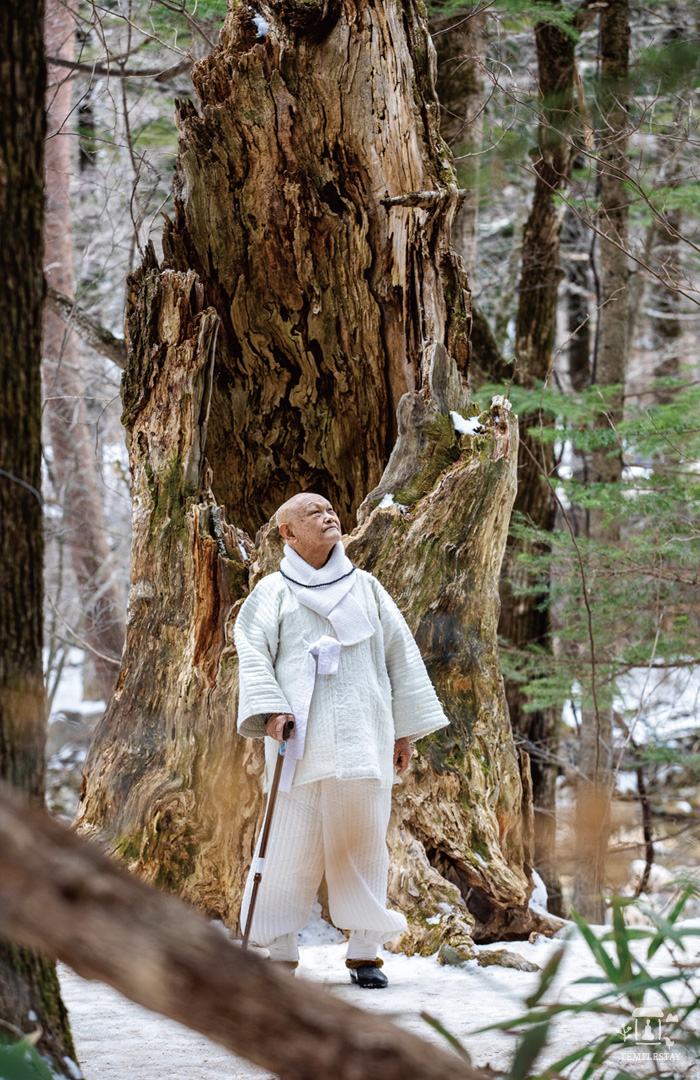
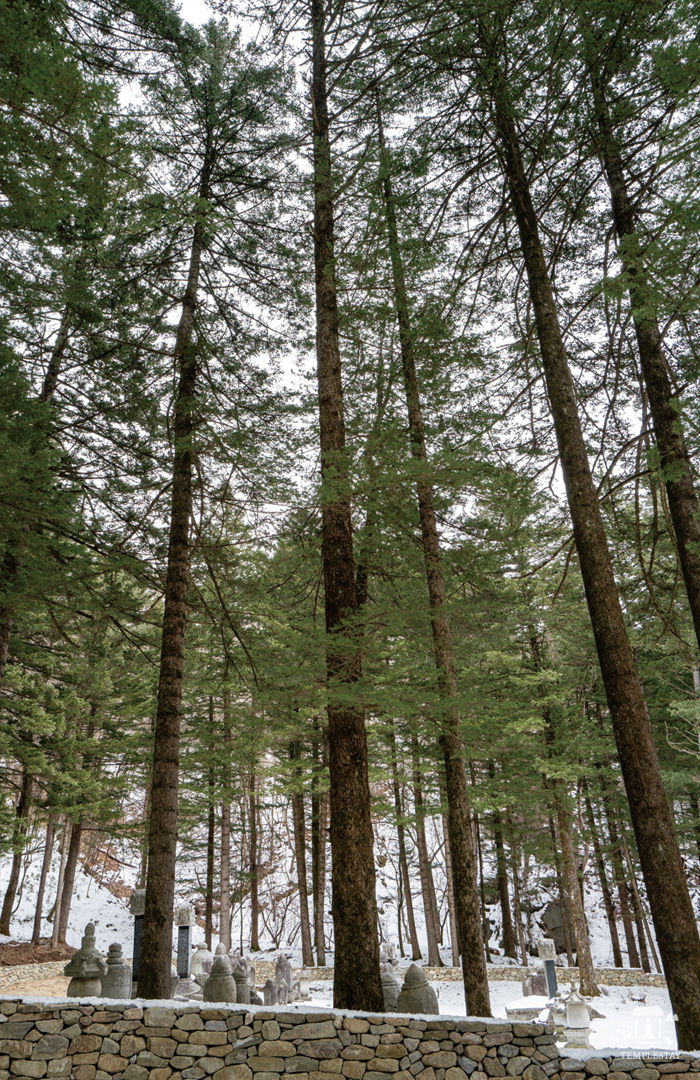
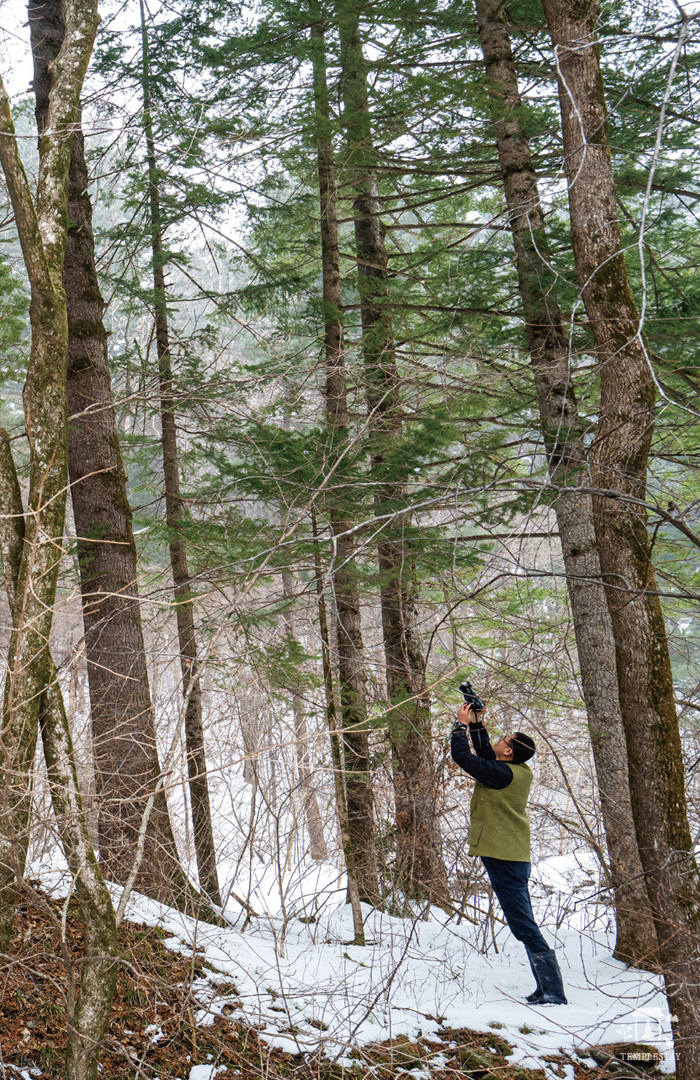
“We must make sure to preserve photos of actual sites, such as the company street and pencil factory that pulsed with the joys and sorrows of local residents, the bomagi built to store felled trees, the traces of the sawmills and railroads, and evidence of the resin extraction facility. Many people who remember the past have already died. It's a painful history, but even if it eventually disappears over time, shouldn't it be shown to people who visit Woljeongsa Temple? You have to see the reality to experience the emotions, otherwise it's just a story or a fantasy in a novel. We must remember the painful things that occurred in this forest.”
The wounds the forest suffered were deep, and many thought they would never heal, but they did, and it didn't take long. After the 1961 May 16 military coup, a forest restoration plan was implemented and full-scale slash-and-burn clearing and tree planting projects were promoted nationwide. Woljeongsa Forest also progressed rapidly, beginning in 1975 when it was designated a national park. The slash-and-burn farmers—who at the time numbered approximately 2,500 people in 360 households—were relocated, and the land they had destroyed began to be restored. Japanese larch trees—now seen all along Seonjae-gil mingled in with the native broad-leaved trees—appear to have been planted at that time. According to Ven. Wonhaeng, monks also started planting trees at this time. The planting of trees throughout the forest was encouraged by paying daily wages to village residents, and efforts were made to prevent logging, enforced by the mountain stewards.
Nevertheless, most of the forests around Seonjae-gil were restored naturally over time. The seeds left behind by the large broad-leaved trees—including the iron birch and Korean birch trees that were cut down—have now developed into a mature forest again. The average age of broad-leaved trees here is around 70 to 80 years, which is not very old, but it is very rare to even find forests this old in Korea.

Recently, in Gangwon-do, native forests are being cut down to make room for white birch trees, a non-native species. Even without human intervention, native trees grow and germinate here naturally to give us a more beautiful forest. All lifeforms are born with their own karma and faithfully live out their destiny. The present life is also the foundation for the next life, so the importance of life cannot be judged. You have no right to destroy another life without reason. In a forest, many lifeforms come together and live in symbiotic relationships to achieve harmony and balance. The beauty of the forest is in the harmony and balance created by countless lifeforms living together over a long period of time.
“A temple forest contains the history of the temple. It is meaningless to visit a temple forest as just “something to do.” We need to create a research institute which specializes in the study of temple forests and hire professional researchers to do long-term studies. Since the ecological rhythm of a forest changes over time, I believe there will be a better future for us only if we make an effort to know and understand the forest. Through this, we must allow the public who visit Woljeongsa Forest to feel a real sense of the vitality of life. Meditation, Seon practice, and spiritual practices like reciting the buddhas' names and reading sutras are all good, but we need to actually introduce them to the forest and show them how past Seon masters protected this majestic, beautiful forest and how it is changing. The lush, dense forest, Woljeongsa Temple, and the animals and plants living here all teach us the importance of life and coexistence.”
The forest will remember its history of pain. It is silent, as if trying to keep the pain to itself. Nevertheless, our heart wants us to visit Woljeongsa Forest to share those memories. Now, we should walk the forest of Woljeongsa Temple and share the memories of Woljeongsa Temple which has absorbed and mitigated the pain of this forest with its spirit.
Hong Seok-hwan is a professor in the Dept. of Landscape Architecture at Pusan National University and an expert in the field of environmental and ecological planning. He loves and respects the vitality of forests and seeks to find solutions by thinking deeply about the role of forests in responding to the climate crisis. He is the co-chairman of the Climate Disaster Research Institute, a member of the Jogye Order's Environmental Committee, and a member of the Environmental Committee of Yeongchuk Chongnim Tongdosa.
Woljeongsa Temple
+82-33-339-6800
http://woljeongsa.org





